|
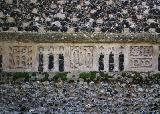 
 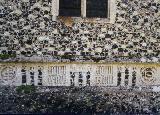
The tower was built between 1460 and 1500 by a consortium of local benefactors who had their names inscribed in stone at the base of the tower and whose wills show them to be closely related - as one would expect in such a small community. Here, thanks to detailed notes on the church courtesy of John Fitch M. A. aided by Mr. Peter Rattlesden the inscriptions are brought to life: "On the North face of the Tower are three carved panels: (left to right) the crowned M monogram of the Virgin Mary; the HIS (Jesus) monogram in a twisted wreath with a "fleur de lis" in each corner and in the third panel what appear to be the letters IS and IR with, between them the emblem of priesthood (a chalice and Host) in the top half and on the lower the letters P.D.". On the west face four panels; (left to right) the interwined letters ST (Sancta Trinitas?); John Watt; John Reeve; the Agnus Dei emblem. On the South side are four names which, worn though they are, Mr Rattlesden plausibly deciphers as Sir John Dowham, Margaret Reve, Jafrey Skytte and William Toller."
|
|
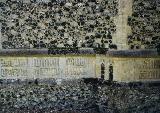 
 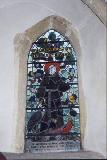
Leaving out some unexplained initials on the North side the six individual names on the tower all made or are mentioned in Wills between 1463 and 1504.
The final unsolved problem in the history of this little church is inside. On the South wall high up opposite the pulpit is an arch containing examples of mediaeval scroll painting but which bears relation to nothing else in church. This can be seen in the picture below and, if one downloads the Ipix Viewer, insitu.
|
|
 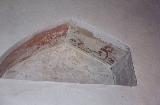 Within are a 13th or 14th century font and an early 14th century screen, crude and heavy in design but with a curious roughly cut double arch in one panel of the dado, possibly a primitive confessional. The altar cross, candlesticks and the processional cross all in wood are modern and made by a local forester. There are some fragments of mediaeval glass in the South chancel window but otherwise all the stained glass is Victorian, the best of which are three charming lancet windows on the North side representing Faith Hope and Charity. On the South wall of the chancel there is a window by Harcourt Doyle (1952) depicting St. Francis amid Breckland flora and fauna - note the kingfisher.
Within are a 13th or 14th century font and an early 14th century screen, crude and heavy in design but with a curious roughly cut double arch in one panel of the dado, possibly a primitive confessional. The altar cross, candlesticks and the processional cross all in wood are modern and made by a local forester. There are some fragments of mediaeval glass in the South chancel window but otherwise all the stained glass is Victorian, the best of which are three charming lancet windows on the North side representing Faith Hope and Charity. On the South wall of the chancel there is a window by Harcourt Doyle (1952) depicting St. Francis amid Breckland flora and fauna - note the kingfisher.
The memorials relate to the various landowners and their families connected with the village, nobably the Wright's from the 17th and 18th centuries, through the Cadogans to the last 'squire', Colonel Edward Mackenzie who died in1929. Outside in the graveyard, near the gate is to be found the remains of a mediaeval churchyard cross, from the time when a single cross or crucifix commemorated all souls.
|
|
|
|
|
|
|
|
|
|
|
|
|
Copyright 2016 TJKSoftware,Icehouse Media,Sally McIrvine ~ designed & maintained by
TJKSoftware

